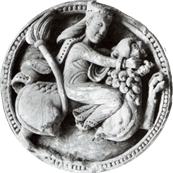

Join Keynsham & Saltford Local History Society to find out more about your area


Join Keynsham & Saltford Local History Society to find out more about your area
VISITS & WALKS 2018
APRIL 28th GUIDED WALK AROUND THORNBURY
Twenty members enjoyed a guided walk around the town of Thornbury. The guides were volunteers from the Thornbury Museum and before we started there was an opportunity to look round the Museum and see the wide range of artefacts reflecting both the history and the past occupations of the residents of the town. Our party was then split into two groups for the walk. Amongst many interesting features, we saw the site of the railway station, the historic shops that survive in the High Street, the parish church of St Mary and the entrance to Thornbury Castle. The town is now of a similar size to Keynsham, but retains a wealth of old buildings, which makes it much easier to connect with its past and gives it a character and variety of architecture that we have lost.
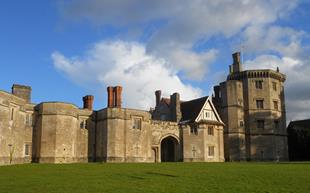
Thornbury Castle, now a hotel
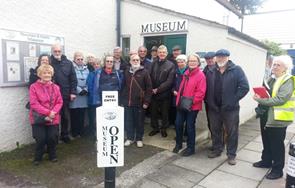
Members of the Society outside Thornbury Museum
MAY 10th COACH TRIP TO KNIGHTSHAYES COURT AND WELLINGTON
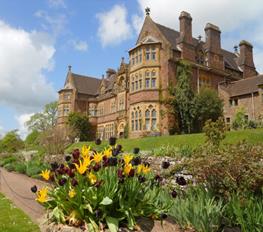
Knightshayes Court
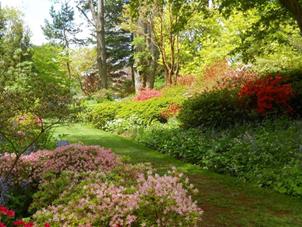
The grounds at Knightshayes
Our first coach trip of the year was to Knightshayes Court, near Tiverton. The house, now owned by the National Trust, was built about 1870 for Sir John Heathcoat-Amory, who owned the lace factory in the town. He appointed William Burges as architect. Burges is most famous for his work at Cardiff Castle for the Marquis of Bute and his designs for Knightshayes were in similar imaginative style. However, client and architect fell out and Burges was sacked in 1874, by which time the building had been constructed but the interior decoration and furnishing was incomplete. Many of the rooms that we saw on our visit were to designs by his successor John Crace although some of Burges’ wonderful designs have been uncovered or restored in recent years. The house is not especially large but the decoration made it a memorable visit.
Besides the house, the gardens and grounds at Knightshayes are extensive and a delight to explore. The azaleas were in flower, with many varieties and colours. The walled kitchen garden has been restored over the last ten years and now produces a wide range of flowers and vegetable for the Trust. After leaving Knightshayes, we called at the town of Wellington where some of our party visited the local Museum, whilst others were content to find refreshments.
JUNE 7TH A GUIDED TOUR OF THE UNDERFALL YARD
The Underfall Yard is part of the historic fabric of Bristol Docks and some elements of it are still key to the operation of the Floating Harbour. Our tour included the history of the yard, and what its name means, then visits to the various elements of the site. We saw the huge sluice-gates that control the level of the Floating Harbour, the machine shop – which contains metal-working machines that have disappeared from most workshops long ago – and a demonstration of the engines that provided power to the hydraulic system that once powered the lock gates and much else besides.
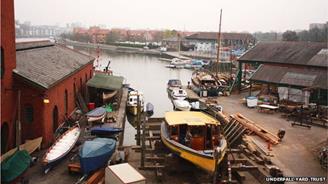
A view of the slipway and yard
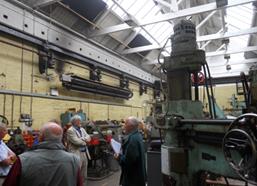
The machine shop
JULY 5th A GUIDED TOUR OF BRISTOL CATHEDRAL
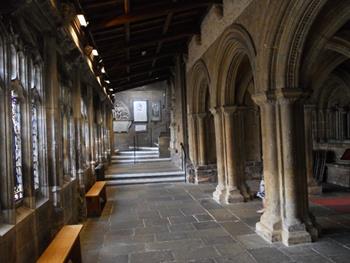
The Cloisters
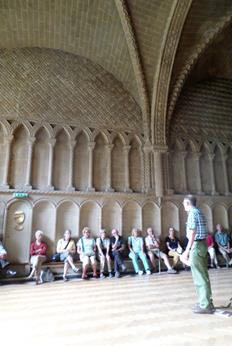
Tour guide Keith Norton
Thirty members visited Bristol Cathedral for a most interesting tour, led by Society treasurer Keith Norton, who is a guide at the Cathedral. It is often not appreciated that the Cathedral was built as Bristol Abbey and until the Dissolution of the Monasteries was run by the same religious order as Keynsham Abbey, so a knowledge of the former tells us much about the long-vanished establishment at Keynsham, regarding both its architecture and its operation.
Bristol Abbey was built about 1140 under the rule of the Victorine order of Augustinian Canons. Although some parts became redundant at the Dissolution and have been lost, the building retains some of the finest examples of Norman, or Romanesque, architecture in Britain. We saw the imposing Chapter House and the remaining parts of the Cloisters. Our guide explained the architectural history of the choir and nave, built separately, as well as some of the many memorials in the aisles. Most of our group were familiar with the Cathedral from the outside but few of us had had a tour, so everyone learned a great deal!
SEPTEMBER 12th COACH TRIP TO THE MARY ROSE MUSEUM, PORTSMOUTH
After a journey via the M4 and A34 we arrived in Portsmouth at 11.00am. There is a walk past some of the Historic Dockyard’s other attractions, including HMS Victory, to reach the Mary Rose, now forming the centre-piece of a modern museum. After introductory galleries explaining how the ship was lost at the Battle of the Solent in 1545, we had our first glimpse of the hull, or rather the half of it that has survived. It is magnificently presented, with changing lighting and animated scenes showing recreations of the sailors and others on board going about their work. On the opposite side of the main walkway displays show some of the thousands of finds recovered from the mud. Further galleries explore particular occupations, such as that of the ship’s carpenter, whose chest was recovered with a complete set of his tools, and the surgeon.
The Museum gives a unique insight into life on a Tudor warship and the use of the latest technology to interpret and present what was found makes it fascinating and memorable experience.
Some members of the party found time to visit other nearby attractions including HMS Victory, the exhibition on the Battle of Jutland and for those with a head for heights, the Spinnaker Tower. The coach returned via Salisbury and Bath for some pleasant views of the Wiltshire countryside.
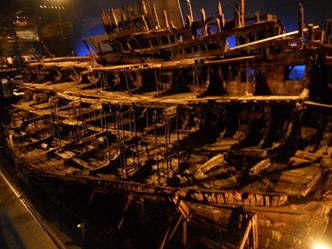
The hull of the Mary Rose.
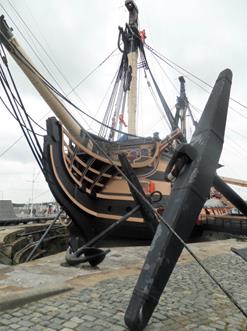
The Victory